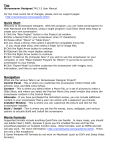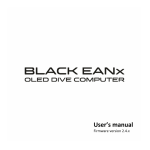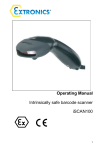Download Wiley ActionScript: Your visual blueprint for creating interactive projects in Flash CS4 Professional
Transcript
Introducing Flash A dobe Flash is the industry-standard application for creating animation and playing video on Web sites. It is fairly easy to learn when you are first getting started but has many powerful features that enable advanced developers to create full Web sites, interactive games, or almost anything else they need. Flash was originally developed under the name FutureSplash. At the time, it was a simple tool for creating animation. Macromedia purchased it in 1997 and changed the name to Flash. Flash was the primary motivation for Adobe to purchase Macromedia in late 2006. AL The Flash Platform TE RI Today, Adobe markets a series of products under the Flash Platform. All of these products can work together to develop Flashbased applications for a variety of delivery systems. The Flash Platform’s two primary applications are Flash CS4 Professional and Flash Player, but the Flash Platform also contains the Flex 3 platform, several server-based products including the Flash Media Server, and Flash Lite. The Flex Platform Flash CS4 Professional is the primary integrated development environment (IDE) for developing Flash movies. When you think of “learning Flash” or “using Flash,” this refers to learning or using Flash Professional, and it is the application that is discussed throughout this book. Unless stated otherwise, any further references in the text to Flash should be assumed to mean Flash CS4 Professional. Flex offers a more developer-centric environment than Flash. Flex is an open-source platform that enables developers to create visual layouts in an XML-derived markup language called MXML and to add interactivity and back-end connectivity through ActionScript 3.0. Regardless, Flex applications are viewed by the user through Flash Player, and unless the site specifies it, there is no real way to look at a Flash-based site and know whether it was created in Flash Professional or Flex. TE D MA Flash CS4 Professional GH Flash Player PY RI Flash Player is the free application used to view Flash movies. Regardless of the tool used to create a Flash movie, your users actually view and interact with it through Flash Player. Flash Player is the single most-installed software, with current estimates putting it on more than 99 percent of computers worldwide. CO As of the release of Flash CS4 Professional, Adobe has also released Flash Player 10. Flash Player has enjoyed recordbreaking adoption rates, with previous versions averaging six million downloads per day. 2 FLEX BUILDER The Flex platform is open source and can be downloaded from the Adobe Open Source Web site, http://opensource.adobe. com. Although Flex applications can be created in any text editor, Adobe has developed an IDE to assist in the creation of Flex applications called Flex Builder. Built on the open-source Eclipse toolset, Flex Builder is available for purchase from Adobe’s Web site. FLASH CATALYST In late 2007, Adobe announced that it had begun development of a new application in the Flex platform. This tool, at the time code-named Thermo, would enable designers to take visual compositions, created in applications such as Adobe Photoshop, and easily convert them to Flex applications. In November 2008 at Adobe MAX, the company’s annual developer’s conference, Adobe announced that the product would be officially named Flash Catalyst and that the product would be released sometime in late 2009 or early 2010. Flash Media Server Flash Lite Flash Media Server enables you to deploy streaming media such as video through Flash Player. Flash Media Server works as an intermediary between a Web server and the browser to deliver the content seamlessly. Any Flash video can be deployed to a Flash Media Server. Flash Lite is a version of Flash Player designed specifically for cell phones and other mobile devices. Many new cell phones allow their users to play games created in Flash and deployed to Flash Lite; some new phones even use Flash for all the menus and other interface elements. You can test Flash applications in Flash Lite using the tool Device Central, which is included with Flash Professional. Chapter 1: Introducing ActionScript The Flash Platform (continued) Vector Art Flash uses vector art to create graphics. Traditional graphics applications and formats such as JPG and GIF are known as raster or bitmap art. These images are made up of pixels. If you think of your computer screen as a large sheet of graph paper, each square of the graph represents a pixel. By filling in each square with a color, you can create full-color images. However, raster images are dependent on the resolution at which they were created. In order to double the size of the image, each colored pixel needs to expand to fill four squares, or pixels; quadrupling the size of the image forces each pixel to fill eight pixels, and so on. Eventually, these ever-expanding squares will be noticeable in the image, causing the file to become pixelated. In addition, each of these size increases has a proportional impact on file size: Doubling the pixel dimensions of an image roughly quadruples the file size. It is therefore impossible to resize a raster-based image without affecting the file size and quality. Vector programs take a radically different approach. Rather than fill in squares, you create vector art by defining points and then having the program use mathematical algorithms to calculate a line or path between the points. The path can be either straight or curved, and the space between the points can be filled with color. In a vector image, resizing is accomplished by moving the two points either farther apart or closer together and having the program recalculate the math. Therefore, you can freely resize vector images without affecting either the file size or the quality of the image. Most graphics programs today lean toward being either vector-based, such as Adobe Illustrator, or raster-based, such as Adobe Photoshop. Both, however, contain tools to work in the other methodology. Photoshop, for example, contains a set of vector-based tools, whereas Illustrator contains some tools for editing raster graphics. Flash, on the other hand, is purely vector-based, and you will not find any raster manipulation tools in it. Although you can import raster graphics into a Flash movie, and those graphics can be animated, you cannot edit the graphic without first converting it to vector format. The only exception is that raster graphics can be resized in Flash, but as they are raster images, they become pixelated if resized too much. Creative Suite 4 Flash CS4 Professional is marketed as a part of Creative Suite 4. The suite includes a series of integrated applications that provide a set of tools designers and developers can use to create Web, video, and print applications. Adobe currently offers four main editions of CS4 and includes Flash in each of them. 3 Understanding Flash Player 10 T he most important application in the Flash Platform is Flash Player. With the release of Flash CS4 Professional in late 2008, Adobe also released Flash Player 10. At the time of this writing, Flash Player 10 was too new to be included in studies, but according Downloading and Installing Flash Player Even though the overwhelming majority of computer users worldwide have Flash Player installed on their machines, you may still encounter users who, for a variety of reasons, do not have the player installed or have an older version that will not support ActionScript 3.0. Fortunately, this issue is generally very easy to handle. Your users can manually visit Adobe’s Web site at www.adobe.com and click the Get Adobe Flash Player button. Alternatively, you can include code in your HTML document that will detect the lack of the player or an outdated version and automatically prompt the user to install the Flash Player. If you create your HTML document using Adobe Dreamweaver CS4, this functionality is included automatically in the code that is added to the page when you insert a Flash movie. Flash Player Debug Version The “normal” version of Flash Player does not include the ability to debug troublesome ActionScript code. However, Adobe has developed a special Debug version of the Player with this added capability. You can download the latest version of the Debug Player at www.adobe.com/support/ flashplayer/downloads.html. 4 to a June 2008 study, Flash Player 9 was on 97.7 percent of computers in the United States, Europe, and Asia, whereas Flash Player 8 was on 98 percent of computers in similar regions. Flash Player Versions At the time of this writing, Flash Player 10 is the most current version. Released in late 2008 alongside Flash CS4 Professional, Player 10 was designed to use several new features of Flash, including the ability to render 3D graphics and effects. However, most users today still have Flash Player 9 installed. Almost all the techniques used in this book will work correctly for users on either version 9 or 10, but ActionScript 3.0 is not supported on earlier versions at all. In the cases when Player 10 will be required for your users, it will be pointed out, but if Player 10 enjoys the same adoption rate as past versions, it should only take a year or so for it to become the dominant version on the Internet. Flash Player is available in Windows, Macintosh, and Linux versions. You can view a detailed report on the current rate of adoption of Flash Player on Adobe’s Web page at www. adobe.com/products/player_census/flashplayer/. The site includes data based on the version, locations of users, operating systems, and more. Although the majority of Flash content is delivered through a Web browser, there may be times when you want to allow your users to save a copy of the movie to their hard drive and play it back whenever they choose, even offline. In Flash CS4 Professional, you have the option of publishing your movie to a standalone projector, which is a file that contains Flash Player and the content of your movie. Server-Side File and Scripting Access File System Access Restrictions For security purposes, Flash Player has very little access to the local file system of your users’ computers. Likewise, it cannot generally access their hardware such as printers. If you need to create an application with full local file system and hardware access, you will want to create an application using Adobe Integrated Runtime (AIR) instead. See Chapter 20 for more details on creating AIR applications. Chapter 1: Introducing ActionScript Standalone Projector The ActionScript Virtual Machine Flash is a client-side technology. Flash Player is an application that runs on your user’s machines, not on your Web server. However, Flash Player does have the capability of communicating with the Web server from which the Flash movie was sent via normal HTTP calls — the same as the browser. Flash can request external assets such as images, other Flash movies, sound files, video, and text files and then, through ActionScript 3.0, use that content in the current movie as it plays. See Chapters 17 and 18 for information on accessing and using server-side content in your Flash movies. ActionScript executes in Flash Player via the ActionScript Virtual Machine, or AVM. Traditionally, one of the most difficult aspects of creating and maintaining Web sites is the need to test your HTML and XHTML pages on multiple browsers and across multiple platforms, including Windows and Macintosh. Developers creating content in the Flash Platform are freed from this worry, as the AVM will ensure that all content running in Flash Player will work in precisely the same way, regardless of the operating system the users employ or the browsers through which they accessed the page. Flash Player cannot, under normal circumstances, request data or external access from any server other than the one that delivered the movie. Several techniques exist to work around this issue, which are covered in Chapter 18. With the release of Flash Player 9, Adobe completely rebuilt the AVM, primarily to include support for ActionScript 3.0. Flash Player 9 and 10, and presumably future versions, all include both AVM versions 1 and 2. When the player encounters a file that relies on ActionScript 3.0, it uses AVM version 2; when it renders a file using ActionScript 1.0 or 2.0, it falls back to AVM 1. This is in fact one of the primary reasons why Flash designers should consider switching to ActionScript 3.0: AVM 2 is far more efficient than AVM 1, meaning that similar movies will run faster and smoother if written in ActionScript 3.0 than they will if written in ActionScript 2.0. However, it is also the reason why movies that rely on ActionScript 3.0 require that the end user have at least Flash Player 9. 5 Introducing ActionScript 3.0 Y ou can add interactivity to your Flash movies using ActionScript. By adding interactivity, you can allow users to interact with a movie, triggering an immediate change in the movie. For example, a user may click a button to activate another movie clip or jump What Is ActionScript? to a Web page, or you may set up a movie to stop when it reaches a certain frame. Interactivity can be as simple as a button click or key press or as complex as an e-commerce site or an online videogame. ActionScript Versions ActionScript is an object-oriented programming language based on scripts. Scripts are simply short statements that tell Flash what to do. ActionScript statements are composed of code based on the ActionScript language. When you assemble several statements, you create a script. You can control parts of the script by specifying parameters. For example, you can write a script that tells Flash to go to and play a particular frame in your movie. When assigning this action, you set the parameter for the action by designating a particular frame in your movie. As a Flash developer, you can choose to work in any of the three versions of ActionScript: 1.0, 2.0, or 3.0. ActionScript 3.0 is the newest version and has been thoroughly redesigned to support today’s growing Web design needs. ActionScript 3.0 is based on ECMAScript — which is the same standard JavaScript is based on — and works best for users familiar with object-oriented programming. ActionScript 3.0 executes much faster than previous versions and is designed to allow developers to create highly complex Flash files. With ActionScript, you can write instructions that tell Flash to respond to mouse clicks and key presses a user might perform while viewing a movie, or you can request information from the user and have your Flash movie respond to the information the user provides. You can also use ActionScript to animate objects in your movie, and you can combine statements to produce sophisticated interactive elements for your movies. ActionScript 2.0 is simpler than 3.0, but it is slower to execute in Flash Player. ActionScript 1.0 is the simplest form of ActionScript and is not as commonly used today. Flash Player 9 supports all three versions of ActionScript. Assigning ActionScript Versions When you start a new file in Flash, you have the option of choosing which version of ActionScript to base the file on. The Welcome Page and the New Document dialog box list both ActionScript 3.0 and ActionScript 2.0. You can also use the Publish Settings dialog box to change which version of ActionScript is associated with the file. You can assign only one version of ActionScript to a file. 6 Because of its many advantages and increased functionality, this book focuses on using ActionScript 3.0 to build interactivity. To run movies created with ActionScript 3.0, your users must use Flash Player 9 or later. Unless you are writing scripts in an ActionScript text file, all ActionScript 3.0 instructions are attached to keyframes in your movie. As such, it is good practice to manage ActionScripts by placing them in one easy-to-locate place in your movie. You should create a new layer and place all ActionScript in the first keyframe of the new layer. After you establish a location for your scripts, you can open the Actions panel and start adding ActionScript. Most developers make this layer the top-most layer in the Timeline to make it easy to find. The Actions panel is where you can add ActionScript to your movie. The panel includes a text editor for adding and editing script, a toolbox of common scripting codes, and a navigator area for viewing what scripts are assigned to what items in a movie. The Actions panel even offers a Script Assist mode to help you add actions without having to know a lot about writing scripts. However, if you are an experienced developer, you may prefer to use the special authoring environment for writing your code. You can write your own scripts separately from your Flash movies in an external Script window. You can use the external Script window to write ActionScript, Flash Communication, or Flash JavaScript files. See the Flash Help files to learn more about using the Script window. If your Flash projects require form elements and user interface controls, such as check boxes, radio buttons, and list boxes, you can use components. Components are prebuilt, complex movie clips. Although prebuilt, components still require you to add some ActionScript coding of your own. Components are available in ActionScript versions 2.0 and 3.0. Chapter 1: Introducing ActionScript Using ActionScript in Flash Other ActionScript Editors Although this book focuses entirely on using Flash CS4 Professional to edit ActionScript, there are other editing tools available for working in the language. If you have not yet upgraded to Flash CS4, you can add and edit ActionScript 3.0 in Flash CS3 Professional, although any version of Flash before that will not have support for ActionScript 3.0. You can add ActionScript 3.0 to Flash movies only in Flash, but as will be discussed in later chapters, there will be many occasions in which you will need to create ActionScript 3.0 in completely separate files. Because ActionScript 3.0 is composed only of text, you can in fact use any text editor. However, a plain text editor such as Notepad on Windows or TextPad on Macintosh will allow you to enter the code, but it will not provide any code coloring or code completion to help in your development. Adobe currently has two applications on the market that support ActionScript 3.0 and provide a better development environment than a plain-text editor. One is Dreamweaver CS4. You can create a new ActionScript 3.0 file from Dreamweaver’s New File dialog box, and the program will provide code coloring and limited code completion. Even more powerful is Flex Builder 3. Because Flex applications rely heavily on ActionScript 3.0, Flex Builder 3 provides a powerful development environment for ActionScript 3.0. Its code completion for ActionScript 3.0 is far superior to Dreamweaver’s and, at times, even surpasses that provided by Flash. 7 Create a New Flash Movie Y ou can begin working in Flash and ActionScript 3.0 very easily by creating a new, blank file. You can add assets to the file, commonly referred to as a movie, and control those assets through ActionScript 3.0. In Windows Vista, you can launch Flash CS4 Professional from the Start menu. In the All Programs menu, you should see a folder labeled based on the edition of the Creative Suite that you purchased. In that folder, you will find a shortcut to Flash that you can click to launch the program. If you use a Macintosh computer, you should find Flash on the Dock after it has been installed, and you can simply click it to open Flash. When Flash first opens, you will be presented with a Start screen that provides the ability to create one of several different types of files. In order to use ActionScript 3.0 in creating a Flash movie, your first option is to create a Flash File (ActionScript 3.0). You can also use ActionScript 3.0 if you select Flash File (Adobe AIR); AIR will be discussed in detail in Chapter 20. It is also possible to create a document that contains nothing but ActionScript code by clicking the ActionScript File option. See Chapter 6 for a discussion on when you might need to do this. Create a New Flash Movie Note: These steps show how to open Flash in Windows Vista. If you own a Macintosh computer, click Flash on the Dock and skip to step 5. 1 2 Click Start. Click All Programs. 2 1 3 Click the edition of Creative Suite that you own. Note: The Creative Suite Master Collection is shown in this example. 4 Click Adobe Flash CS4 Professional. 3 4 8 5 5 Click Flash File (ActionScript 3.0). A new, blank document opens. Chapter 1: Introducing ActionScript Flash opens and displays the Start screen. If you already have another document or movie open in Flash and want to create a new file, you can also click File ➔ New. The New Document dialog box that appears will present you with the same options that appear on the Start screen, along with two additional choices for creating a Flash Slide Presentation, which allows you to use Flash to create a PowerPoint-like document, and a Flash Form Application for creating movies that rely on user input. Although both of these documents can use ActionScript 3.0, neither are covered in this book. Flash CS4 Professional uses many of the same keyboard shortcuts as other applications when performing similar tasks. Therefore, you can also press Ctrl + F (Ô + F) to open the New Document dialog box. The dialog box, regardless of how you open it, will default to the document type you created last or to Flash File (ActionScript 3.0) if you are just getting started, so in most cases you can simply open it and then press Enter on your keyboard to create the required document. 9 Using the Actions Panel Y ou can use the Actions panel to write, format, and edit the ActionScript that you include in your FLA file, or authoring file. There are three parts to the Actions panel: the Actions toolbox, the Script Navigator, and the Script pane. packages of classes. After you become more familiar with the language, you will be able to find script elements you need to add to your code by digging into these packages. When you find what you need, you can simply doubleclick to have that code added to the Script pane. The Actions toolbox contains a list of ActionScript statements. The two top options — Top Level and Language Elements — contain commonly used statements such as variable declarations, looping statements, and the like. The remaining categories in the toolbox are organized based on how Flash Player internally accesses them. ActionScript 3.0 is an object-oriented language, which means in part that it relies on classes. These classes are organized into packages, based on their functionality. Chapter 2 discusses these concepts in detail, but for now, you should just understand that the list of categories that you see in the toolbox represent these The Script Navigator provides a hierarchical listing of all the movie clips, buttons, and frames in your document that have scripts associated with them. You can click an element to view the associated ActionScript in the Script pane. You use the Script pane to type and edit your scripts. The Script pane is a full-featured editor that helps you format your code. It has a toolbar that provides buttons that enable you to add script, find and replace text, insert a target path, check syntax, show code hints, debug your code, and turn on Script Assist. Using the Actions Panel OPEN THE ACTIONS PANEL 1 2 3 Click the frame to which you want to add ActionScript. 2 3 Click Window. Click Actions. You can also press F9 to quickly display the Actions panel or click the Edit ActionScript button in the Properties panel. The Actions panel opens. • The Actions toolbox lists categories, subcategories, and ActionScript code. • You can use the Script pane to add and edit scripts. • The Script Navigator pane lists all the elements by level in your movie, with the current selection at the top. 10 1 You can drag the splitter bar, or border, to change the size of the Actions toolbox and Script pane. • You can click the name of the object for which you want to see any associated code. • You can click the Panel menu to view a context menu of related commands. • You can use the tool buttons to work with scripts that you add to the Script pane. USING THE ACTIONS TOOLBOX 4 • Click a class category to see associated subcategories or codes. 4 Chapter 1: Introducing ActionScript • You can click a subcategory to see a list of codes. Often, you will need the Actions panel to be as large as you can get it to provide the largest possible area for typing. When you need to view the Flash Stage, you can click the panel’s title bar or click the panel’s Minimize button to quickly minimize the panel. You can drag the title bar to move the panel around the screen. You can click the title bar again or click the Maximize button to maximize the panel. Also, if you drag the panel by the Actions – Frame tab to one of the edges of the screen, the panel will dock in that location. The panel contains a set of additional features that make working in code easier. Just above the Script pane, you will find a set buttons that you can use to access much of this functionality. You can simply position your mouse cursor over any of these buttons to see a ToolTip that will indicate the button’s functionality. You will also find a button in the top-right corner of the panel that provides a menu with even more features. 11





















